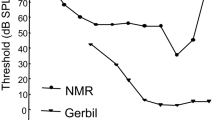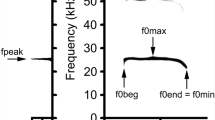Abstract
In captive adult Zambian mole-rats 14 different sounds (13 true vocalizations) have been recorded during different behavioural contexts. The sound analysis revealed that all sounds occurred in a low and middle frequency range with main energy below 10 kHz. The majority of calls contained components of 1.6–2 kHz, 0.63–0.8 kHz, and/or 5–6.3 kHz. The vocalization range thus matched well the hearing range as established in other studies. The frequency content of courtship calls in two species of Zambian Cryptomys was compared with that in naked mole-rats (Heterocephalus glaber) and blind mole-rats (Spalax ehrenbergi) as described in the literature. The frequency range of maximum sound energy is negatively correlated with the body weight and coincides with the frequencies of best hearing in the respective species. In general, the vocalization range in subterranean mammals is shifted towards low frequencies which are best propagated in underground burrows.
Similar content being viewed by others
Author information
Authors and Affiliations
Additional information
Accepted: 16 September 1996
Rights and permissions
About this article
Cite this article
Credner, S., Burda, H. & Ludescher, F. Acoustic communication underground: vocalization characteristics in subterranean social mole-rats (Cryptomys sp., Bathyergidae). J Comp Physiol A 180, 245–255 (1997). https://doi.org/10.1007/s003590050045
Issue Date:
DOI: https://doi.org/10.1007/s003590050045




